[Google Docs] Architecture - Conflict Resolution
Why Conflict Resolution matters in collaborative editing?
Imagine Alice and Bob are editing the same document at the same time.
Original document: ABCDE
- Alice deletes
D - Bob deletes
B
As our expected, the client and server should handle the conflict correctly to ACE.
But network latency is unpredictable, there might be 2 scenarios:
- Alice's operation is applied first
- Bob's operation is applied first
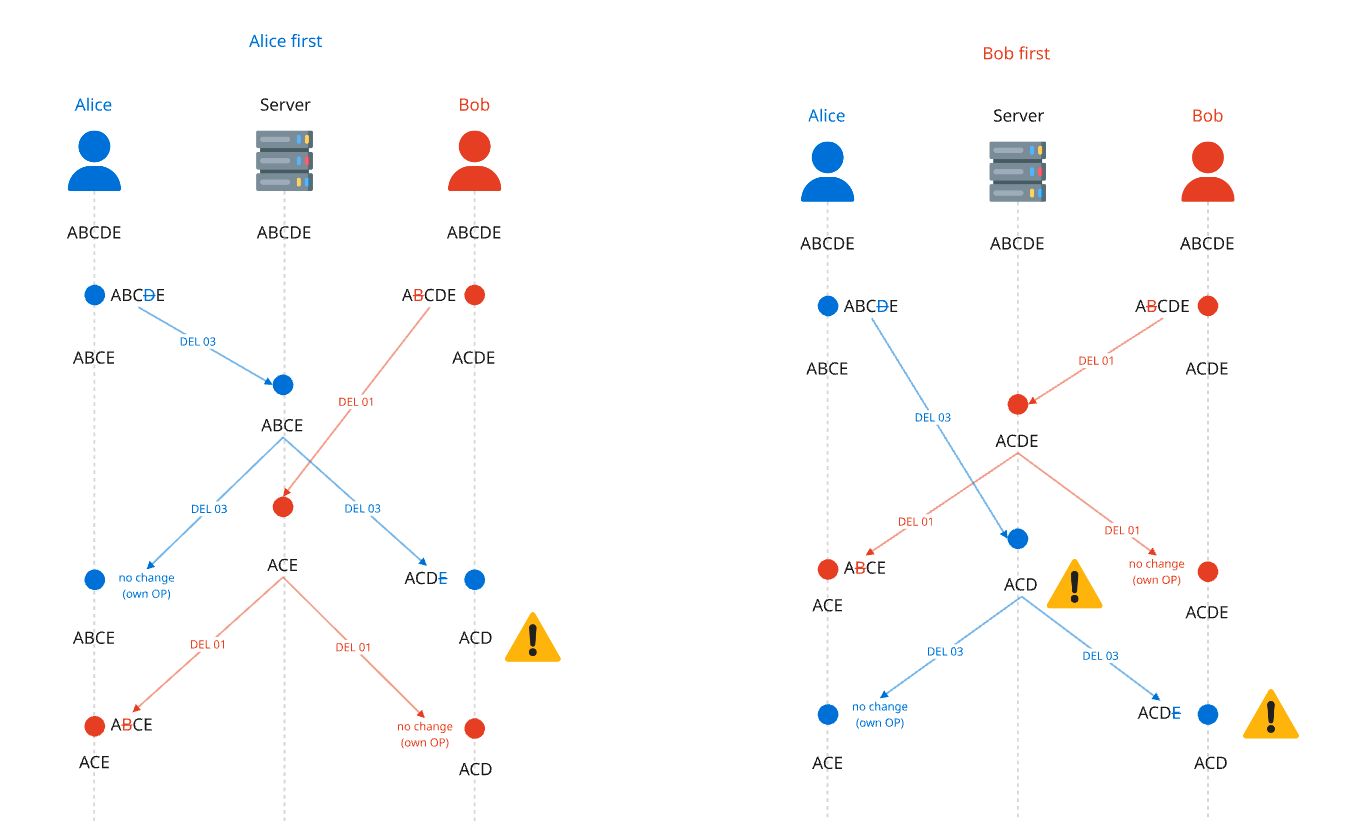
Scenario 1: Alice changes applied first
- Server receives Alice's operation:
DEL 03, and server's stateABCDE->ABCE, and server passed theDEL 03to both Alice and Bob.- Alice receive own operation: no change
- Bob receive Alice's operation:
DEL 03, and Bob's stateACDE->ACD⚠️
- Server receives Bob's operation:
DEL 01, and server's stateABCE->ACE- Alice receive operation:
DEL 01, and Alice's stateABCE->ACE - Bob receive own operation: no change
- Alice receive operation:
Scenario 2: Bob changes applied first
- Server receives Bob's operation:
DEL 01, and server's stateABCDE->ACDE, and server passed theDEL 01to both Alice and Bob.- Alice receive Bob's operation:
DEL 01, and Alice's stateABCE->ACE - Bob receive own operation: no change
- Alice receive Bob's operation:
- Server receives Alice's operation:
DEL 03, and server's stateACDE->ACD⚠️- Alice receive own operation: no change
- Bob receive Alice's operation:
DEL 03, and Bob's stateACDE->ACD⚠️
The result due to Alice or Bob changes applied first is different, that's not what we want.
Therefore, we need Conflict Resolution mechanism to handle the conflict correctly.
And there are 2 main approaches to handle the conflict:
- Operational Transformation (OT)
- Conflict Resolution Data Structure (CRDT)
Who is using OT & CRDT?
| Technology | Product / Company |
|---|---|
| OT | |
| CRDT |
Operational Transformation (OT)
Operational Transformation (OT) is a conflict resolution technique that transforms user's operations to maintain consistency while preserving user intentions.
How it works?
The Server utilizes OT and according to user's current state and intention, transforms operations to make all users state consistent and correct.
Follow by the Alice's and Bob's example:
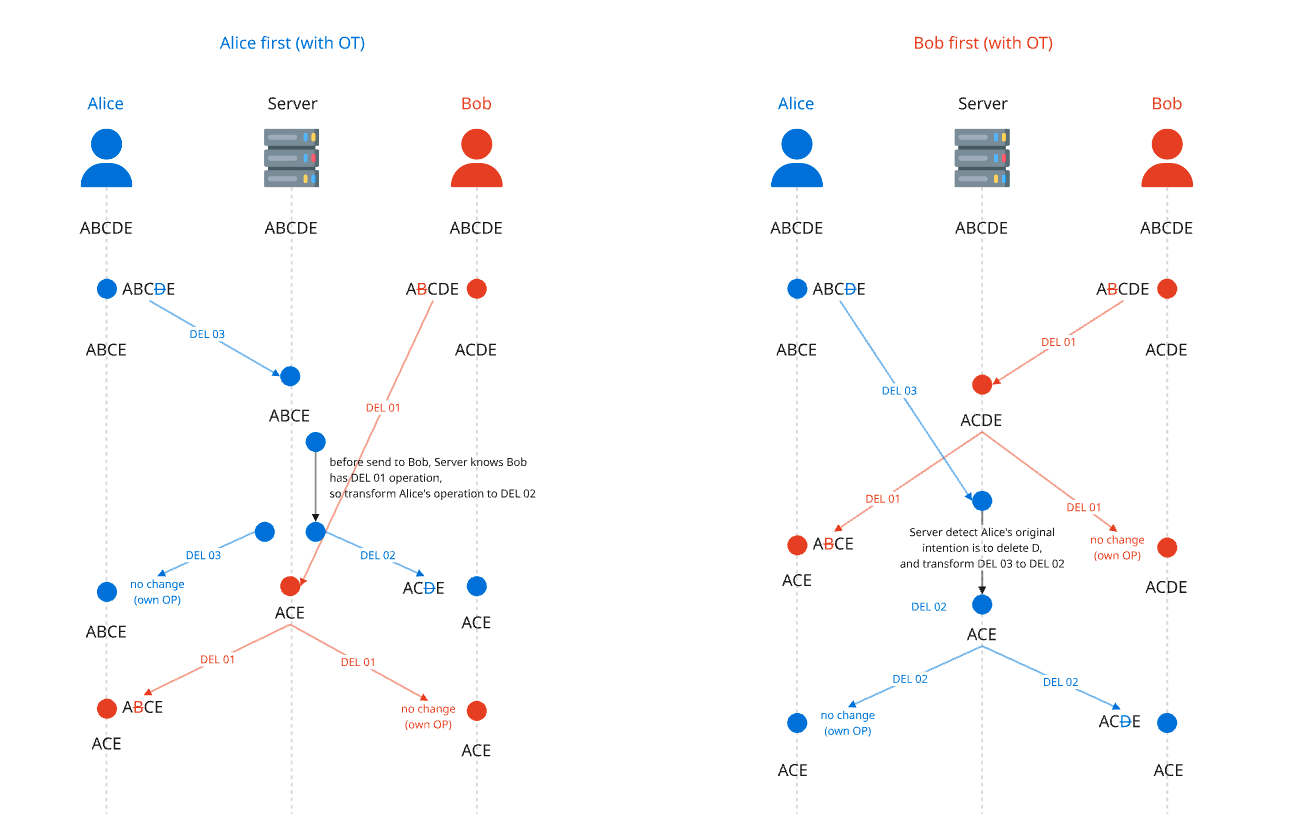
Scenario 1: Alice changes applied first
- Server receives Alice's operation:
DEL 03, and server's stateABCDE->ABCE, and server passed theDEL 03to both Alice and Bob.- Alice receive own operation: no change
- Before sending to Bob, server transforms Alice's operation to
DEL 03->DEL 02
Bob receive Alice's operation:DEL 02, and Bob's stateACDE->ACE✅
- Server receives Bob's operation:
DEL 01, and server's stateABCE->ACE- Alice receive operation:
DEL 01, and Alice's stateABCE->ACE - Bob receive own operation: no change
- Alice receive operation:
Scenario 2: Bob changes applied first
- Server receives Bob's operation:
DEL 01, and server's stateABCDE->ACDE, and server passed theDEL 01to both Alice and Bob.- Alice receive Bob's operation:
DEL 01, and Alice's stateABCE->ACE - Bob receive own operation: no change
- Alice receive Bob's operation:
- Server receives Alice's operation:
DEL 03, before updating Server's state, server transforms Alice's operation toDEL 03->DEL 02, and update Server's state toACE✅- Alice receive own operation: no change
- Bob receive Alice's operation:
DEL 02, and Bob's stateACDE->ACE✅
Pros and Cons
| Features | OT | CRDT |
|---|---|---|
| Consistency | ✅ | ✅ |
| Memory Usage | ✅ (Low) | ❌ (High) |
| User Intent Preservation | ✅ | ❌ |
| Implementation Effort | ❌ (Complex) | ✅ (Simple) |
| Peer-to-Peer Support | ❌ | ✅ |
Conflict Resolution Data Structure (CRDT)
What is CRDT?
Conflict Resolution Data Structure (CRDT) is a data structure that handle concurrent operations automatically, and all users' states converge to the same final state.
We'll use Yjs as our CRDT example.
How it works?
For Yjs, it will create an CRDT object for each operation, which includes
- user id
- Lamport timestamp
Which is used to decide which operation will show first.
To decide which operation will show first, Yjs will use the following rules:
- If the user id is the same, the operation with the smaller timestamp will be shown first.
- If the user id is different, the operation with the smaller user id will be shown first.
Case 1 : 2 users with different User ID
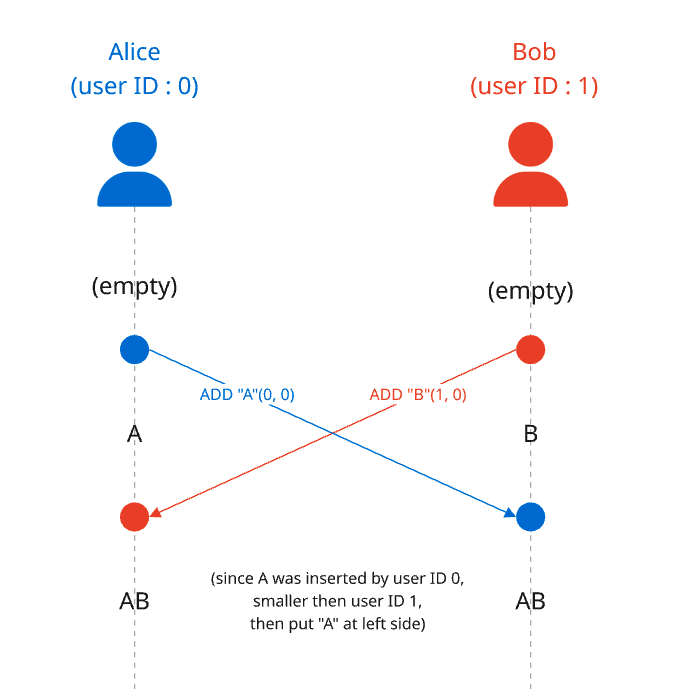
- Alice insert
Aat 0 position - Bob insert
Bat 0 position
Result: AB
Since Alice's user id is 0, which is smaller than Bob's user id 1, A will be shown first.
Case 2 : 1st user with 2 characters, and 2nd user insert with 1 character at the same position

- Alice (user ID : 0) insert
CbetweenAandB - Alice (user ID : 0) insert
DbetweenAandB - Bob (user ID : 1) insert
EbetweenAandB
Result: ACDEB
Process :
- Alice's user id is 0, insert
Coperation will be shown first, - Alice's insert
Doperation will connect toCoperation as Linked List, so it will be shown right afterC - Bob's insert
Eoperation will be shown last, because it's the last operation.
Case 3 : 3 users with different User ID and different timestamp
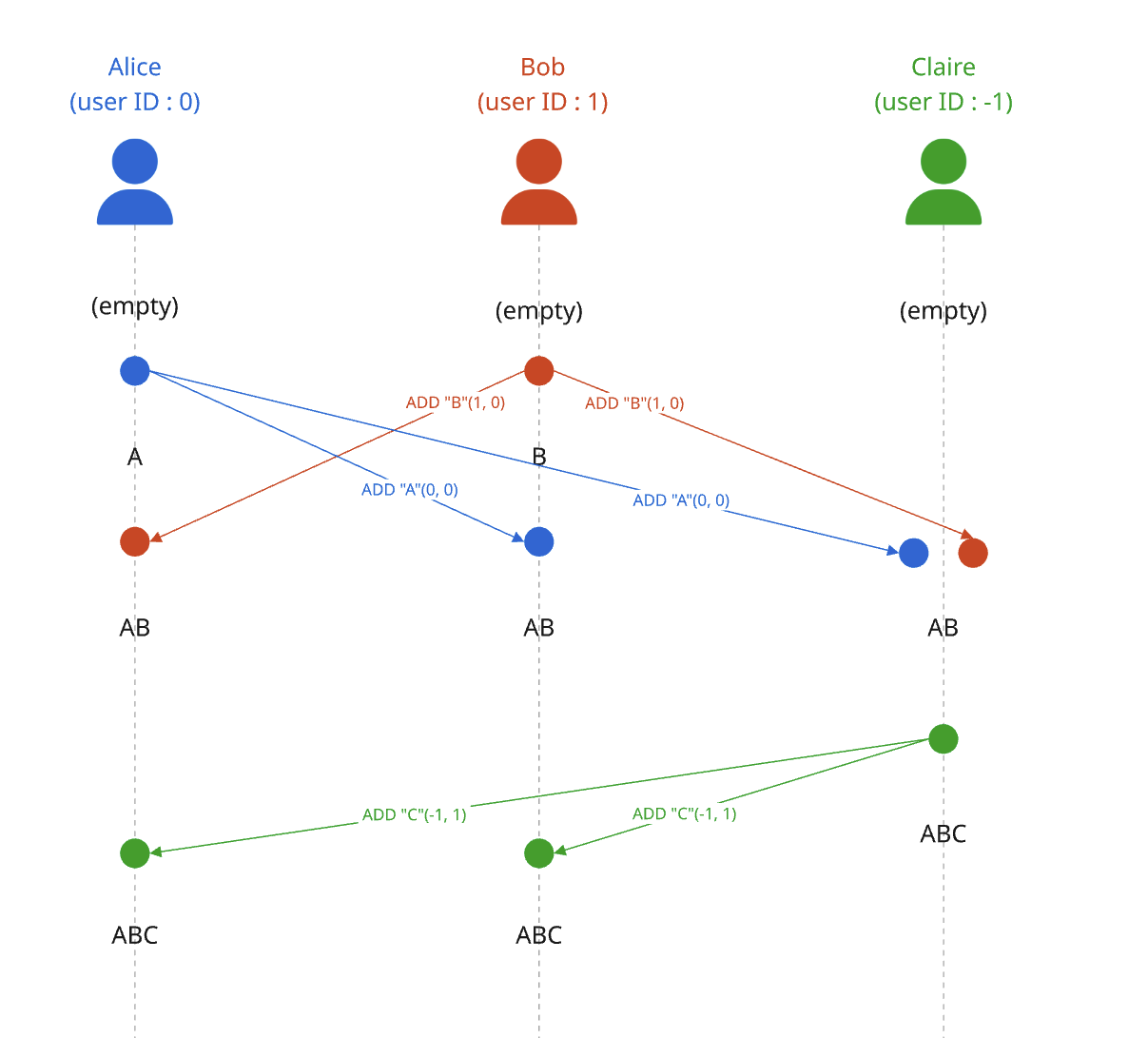
- Alice insert
Aat 0 position at 0ms - Bob insert
Bat 0 position at 10ms - Claire insert
Cat 0 position at 20ms
Result: ABC
Process :
- Since Alice's user id is 0, which is smaller than Bob's user id 1, A will be shown first.
- Bob's insert
Bat 0 position at 10ms, which is greater than Alice's insertAat 0 position at 0ms, B will be shown second. - Finally, even Claire's user id is -1, which is smaller than Alice's & Bob's user id, but the timestamp is 20ms, which makes C's Lamport timestamp is greater than A & B's timestamp, C will be shown last.
Scalability & Performance
Due to solving the conflict, Yjs will create lots of CRDT objects, which will consume lots of memory.
Therefore, Yjs have some strategies to save memory:
- Group characters to save Memory
- Delete children object when parent is marked as deleted
1. Group characters to save Memory
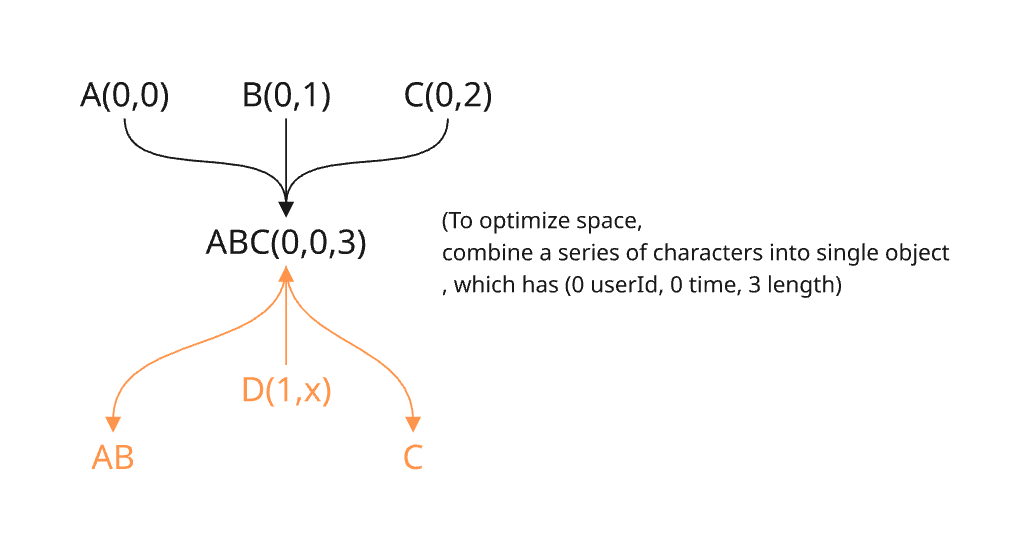
If we directly copy paste the entire sentence (like ABC), it will combine together as one CRDT object.
For example, Yjs will create ABC object with following properties:
userID: 0timestamp: 0length: 3
which lead to ABC (0,0,3)
But if we insert D between B and C, the ABC object will be split into 2 objects: AB and C.
For example, Yjs will create AB object with following properties:
userID: 0timestamp: 0length: 2
And C object with following properties:
userID: 0timestamp: 0length: 1
AB (0,0,2)
C (0,0,1)
2. Delete children object when parent is marked as deleted
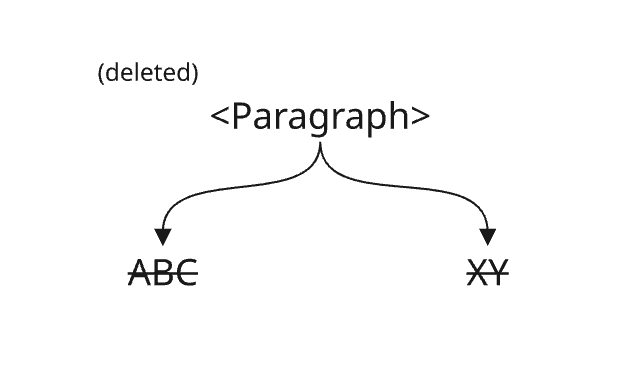
There is another way to save memory, which is delete children object when parent is marked as deleted.
In Yjs, CRDT object cannot be directly deleted, because we need to keep the position to make sure other operations execute on that CRDT object can be handled correctly, but we can mark it as deleted.
For example, if there is an paragraph, which contains ABC, XY, when we mark paragraph as deleted, the ABC and XY will be deleted.
Previous Alice & Bob's example
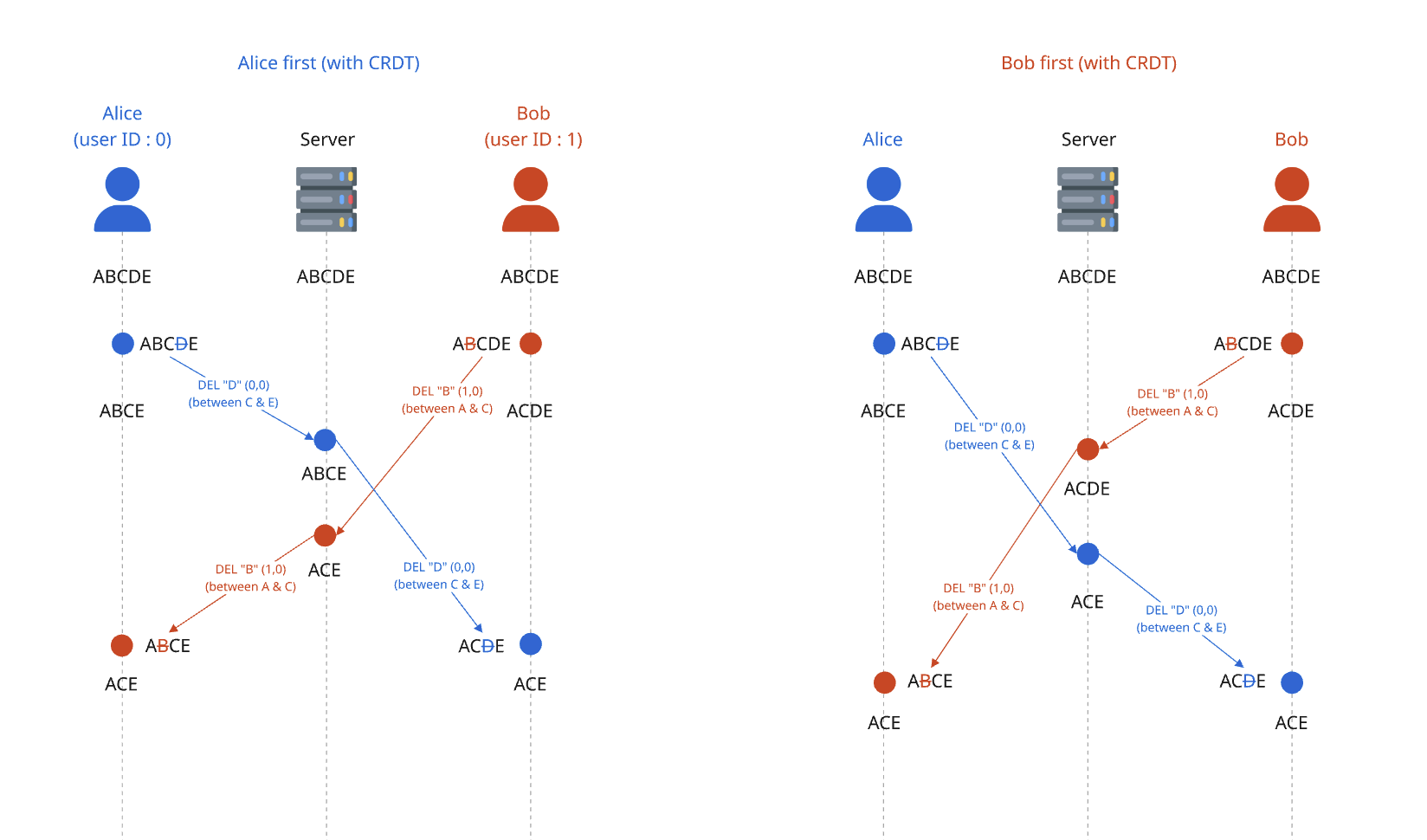
Since Alice's and Bob's insert operation are at different position, for CRDT, each operation can find the correct position to insert the character.
Which will lead to ACE
Pros and Cons
| Features | Rating |
|---|---|
| Consistency | ✅ |
| Memory Usage | ❌ (High) |
| User Intent Preservation | ❌ |
| Implementation Effort | ✅ (Simple) |
| Peer-to-Peer Support | ✅ |
Comparison
Technical Comparison
Operational Transformation (OT)
| Features | OT | CRDT |
|---|---|---|
| Consistency | ✅ | ✅ |
| Memory Usage | ✅ (Low) | ❌ (High) |
| User Intent Preservation | ✅ | ❌ |
| Implementation Effort | ❌ (Complex) | ✅ (Simple) |
| Peer-to-Peer Support | ❌ | ✅ |
Conclusion : Which one to use?
| Requirements | OT | CRDT |
|---|---|---|
| Quickly Iterate (like Figma) | ✅ | |
| Scalability (low memory usage) | ✅ | |
| Keep User Intent | ✅ | |
| Peer-to-Peer Support | ✅ |
References
- GreatFrontend - Google Docs
- Visualization of OT with a central server
- Youtube - A Deep Dive into Yjs part 1
- Wikipedia - Operational transformation
- Wikipedia - Conflict-free replicated data type
- Wikipedia - Lamport timestamp
- Evernote - Future-Proofing Evernote's Foundations
- Zed - CRDTs
- Figma - How Figma's Multiplayer Technology Works
- An introduction to Conflict-Free Replicated Data Types